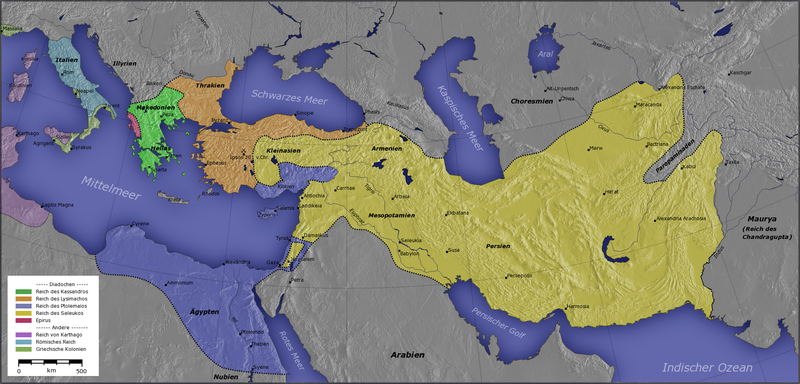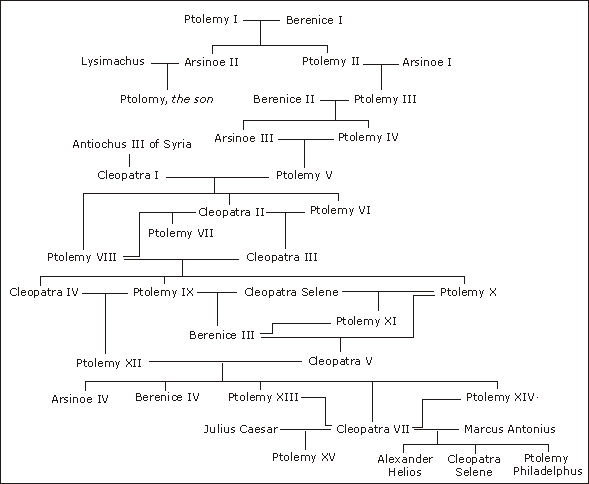Dinastía Ptolemaica - Español
De Wikipedia, la enciclopedia libre
La Dinastía Ptolemaica es aquella fundada por Ptolomeo I Sóter, general de Alejandro Magno. Esta dinastía gobernó en Egipto durante el período Helenístico desde la muerte de Alejandro hasta el año 30 a. C., en que se convirtió en provincia romana. También se la conoce con el nombre de dinastía Lágida, pues Lagos se llamaba el padre (o presunto padre) de Ptolomeo I.
Ptolomeo I estableció la capital de este reino en Alejandría, una gran ciudad en aquella época. Fue uno de los grandes centros comerciales e intelectuales de la antigüedad.
Esta dinastía adoptó desde el principio las costumbres egipcias. Fue constante enemiga de la dinastía macedonia seléucida. Fue durante el reinado de uno de sus monarcas (Ptolomeo V) cuando se publicó (en el 197 a. C.) un decreto en tres tipos de escritura sobre una piedra negra que se conoce hoy en día como Piedra de Rosetta.
En algunos momentos de su historia, la dinastía ptolemaica (o tolemaica) dominó CirenaicaLibia), así como el sur de Canaán y Chipre. (al noreste de la actual
Su último gobernante fue la célebre Cleopatra. Tras su muerte y la de su hijo, CesariónPtolomeo XV), la dinastía concluyó y Egipto fue anexionado por Augusto al Imperio Romano. (
Contenido |
Faraones y reinas [editar]

- Ptolomeo I Sóter (305 a. C.-282 a. C.)
- Tais (cortesana)
- Artacama (esposa)
- Eurídice (esposa)
- Berenice I (esposa)
- Ptolomeo II Filadelfo (284 a. C.-246 a. C.)
- Arsínoe I (esposa)
- Arsínoe II Filadelfo (esposa-hermana)
- Ptolomeo III Evergetes I (246 a. C.-222 a. C.)
- Berenice II (esposa)
- Ptolomeo IV Filopator (222 a. C.-204 a. C.)
- Arsínoe III (esposa-hermana)
- Ptolomeo V Epífanes (204 a. C.-180 a. C.)
- Cleopatra I (esposa)
- Ptolomeo VI Filometor (181 a. C.-164 a. C.) con Cleopatra I, Cleopatra II y Ptolomeo VIII; (163 a. C.-145 a. C.) además con Ptolomeo VII.
- Cleopatra II (esposa-hermana)
- Ptolomeo VII Neo Filopator, nunca reinó, fue asesinado por su tío Ptolomeo VIII.
- Ptolomeo VIII Evergetes II Fiscon (170 a. C.-163 a. C.) con Ptolomeo VII y Cleopatra II; (145 a. C.-116 a. C.) con Cleopatra II y Cleopatra III.
- Cleopatra II (esposa-hermana) (132 a. C.-124 a. C.), enfrentada a Ptolomeo VIII.
- Cleopatra III Kokke (esposa-sobrina) (116 a. C.-107 a. C.) con Ptolomeo VIII y Cleopatra II; (107 a. C.-103 a. C.) y con Ptolomeo IX y X.
- Ptolomeo IX Sóter II Látiro (116 a. C.-110 a. C.) con su madre Cleopatra III; (109 a. C.-107 a. C.) con Ptolomeo X; (88 a. C.-81 a. C.) solo.
- Cleopatra IV (esposa-hermana). Corregente (116 a. C.-115 a. C.). Expulsada por su madre Cleopatra III.
- Cleopatra Selene I (esposa-hermana)
- Ptolomeo X Alejandro I (110 a. C.-109 a. C.) con su madre Cleopatra III; (107 a. C.-88 a. C.) con Ptolomeo IX, que lo asesinó.
- Berenice III (esposa-sobrina). Gobernante (101 a. C.-82 a. C.)
- Ptolomeo XI Alejandro II (80 a. C.)
- Berenice III (esposa-prima). Gobernante (81 a. C.-80 a. C.), fue asesinada por su marido.
- Ptolomeo XII Neo Dionisio Auletes (80 a. C.-58 a. C.) con Cleopatra V y Cleopatra VI; (55 a. C.-51 a. C.) con Cleopatra VII.
- Cleopatra V Trifena (esposa-hermana). Gobernante (58 a. C.-57 a. C.), enfrentada a Ptolomeo XII.
- Berenice IV (hija). Gobernante (58 a. C.-55 a. C.), enfrentada a Ptolomeo XII.
- Cleopatra VII (51 a. C.-30 a. C.).
- Ptolomeo XIII (esposo-hermano) (51 a. C.-47 a. C.) con Cleopatra VII.
- Arsínoe IV (hermana) (48 a. C.-47 a. C.), enfrentada a Cleopatra VII.
- Ptolomeo XIV (esposo-hermano) (47 a. C.-44 a. C.) con Cleopatra VII.
- Ptolomeo XV Cesarión (hijo) (44 a. C.-30 a. C.) con Cleopatra VII.
Titulatura [editar]
| Cartucho egipcio de los ptolomeos: | P T U L M Y S |
|
Cronología gráfica [editar]

Véase también [editar]
Referencias [editar]
- Referencias digitales
- (en inglés) http://www.digitalegypt.ucl.ac.uk//Welcome.html
- (en inglés) http://www.ancient-egypt.org/index.html
- (en inglés) http://www.narmer.pl/indexen.htm
- (en inglés) http://www.phouka.com/pharaoh/pharaoh/pharaohs.html
- (en alemán) http://www.eglyphica.de/egpharaonen
- (en francés) http://2terres.hautesavoie.net/cegypte/texte/chronolo.htm
Enlaces externos [editar]
 Wikimedia Commons alberga contenido multimedia sobre Dinastía Ptolemaica.
Wikimedia Commons alberga contenido multimedia sobre Dinastía Ptolemaica.- Genealogía, Reyes y Reinos: Dinastía Ptolemaica de Egipto
| Dinastía precedente | Periodo helenístico de Egipto | Dinastía siguiente |
|---|---|---|
| Dinastía Macedónica | Dinastía Ptolemaica | Periodo Romano |
Ptolemaic dynasty - Inglés
From Wikipedia, the free encyclopedia
| Dynasties of Ancient Egypt |
The Ptolemaic dynasty, (Ancient Greek: Πτολεμαῖοι, sometimes also known as the Lagids, Ancient Greek: Λαγίδαι, from the name of Ptolemy I's father, Lagus) was a Greek[1][2][3][4]Ptolemaic Empire in Egypt during the Hellenistic period. Their rule lasted for 275 years, from 305 BC to 30 BC. royal family which ruled the
Ptolemy, a somatophylax, one of the seven bodyguards who served as Alexander the Great's generals and deputies, was appointed satrap of Egypt after Alexander's death in 323 BC. In 305 BC, he declared himself King Ptolemy I, later known as "Soter" (saviour). The Egyptianspharaohs of independent Egypt. Ptolemy's family ruled Egypt until the Roman conquest of 30 BC. soon accepted the Ptolemies as the successors to the
All the male rulers of the dynasty took the name Ptolemy. Ptolemaic queens, some of whom were the sisters of their husbands, were usually called Cleopatra, Arsinoe or Berenice. The most famous member of the line was the last queen, Cleopatra VII, known for her role in the Roman political battles between Julius Caesar and Pompey, and later between Octavian and Mark Antony. Her suicide at the conquest by Rome marked the end of Ptolemaic rule in Egypt.
Contents |
[edit] Ptolemaic rulers and consorts

The dates in brackets are regnal dates for the kings. They frequently ruled jointly with their wives, who were often also their sisters. Several queens exercised regal authority, but the most famous and successful was Cleopatra VII (51 BC-30 BC), with her two brothers and her son as successive nominal co-rulers. Several systems exist for numbering the later rulers; the one used here is the one most widely used by modern scholars. Dates are years of reign.
- Ptolemy I Soter (305 BC-282 BC) married first (probably) Thais, secondly Artakama, thirdly Eurydice and finally Berenice I
- Ptolemy II Philadelphus (284 BC-246 BC) married Arsinoe I, then Arsinoe IIPtolemy the Son (267 BC-259 BC) Philadelphus; ruled jointly with
- Ptolemy III Euergetes (246 BC-222 BC) married Berenice II
- Ptolemy IV Philopator (222 BC-204 BC) married Arsinoe III
- Ptolemy V Epiphanes (204 BC-180 BC) married Cleopatra I
- Ptolemy VI Philometor (180 BC-164 BC, 163 BC-145 BC) married Cleopatra II, briefly ruled jointly with Ptolemy Eupator in 152 BC
- Ptolemy VII Neos Philopator (never reigned)
- Ptolemy VIII Euergetes II (Physcon) (170 BC-163 BC, 145 BC-116 BC) married Cleopatra II then Cleopatra III; temporarily expelled from Alexandria by Cleopatra II between 131 BC and 127 BC, reconciled with her in 124 BC.
- Cleopatra II Philometora Soteira (131 BC-127 BC), in opposition to Ptolemy VIII
- Cleopatra III Philometor Soteira Dikaiosyne Nikephoros (Kokke) (116 BC-101 BC) ruled jointly with Ptolemy IX (116 BC-107 BC) and Ptolemy X (107 BC-101 BC)
- Ptolemy IX Soter II (Lathyros) (116 BC-107 BC, 88 BC-81 BC as Soter II) married Cleopatra IV then Cleopatra Selene; ruled jointly with Cleopatra III in his first reign
- Ptolemy X Alexander I (107 BC-88 BC) married Cleopatra Selene then Berenice III; ruled jointly with Cleopatra III till 101 BC
- Berenice III Philopator (81 BC-80 BC)
- Ptolemy XI Alexander II (80 BC) married and ruled jointly with Berenice III before murdering her; ruled alone for 19 days after that.
- Ptolemy XII Neos Dionysos (Auletes) (80 BC-58 BC, 55 BC-51 BC) married Cleopatra V Tryphaena
- Cleopatra V Tryphaena (58 BC-57 BC) ruled jointly with Berenice IV Epiphaneia (58 BC-55 BC)
- Cleopatra VII Philopator (51 BC-30 BC) ruled jointly with Ptolemy XIII (51 BC-47 BC), Ptolemy XIV (47 BC-44 BC) and Ptolemy XV Caesarion (44 BC-30 BC).
- Arsinoe IV (48 BC-47 BC) in opposition to Cleopatra VII
[edit] Simplified Ptolemaic family tree
Many of the relationships shown in this tree are controversial. The issues are fully discussed in the external links.
[edit] Other members of the Ptolemaic dynasty
- Ptolemy Keraunos (died 279 BC) - eldest son of Ptolemy I Soter. Eventually became king of Macedon.
- Ptolemy Apion (died 96 BC) - son of Ptolemy VIII Physcon. Made king of Cyrenaica. Bequeathed Cyrenaica to Rome.
- Ptolemy Philadelphus (born 36 BC) - son of Mark Antony and Cleopatra VII.
- Ptolemy of Mauretania (died AD 40) - son of Juba II of Mauretania and Cleopatra Selene II, daughter of Cleopatra VII and Mark Antony. King of Mauretania.
[edit] Medical analysis
A number of the Ptolemaic dynasty are described as being extremely obese, whilst sculpturescoins reveal prominent eyes and swollen necks. Familial Graves' disease could explain the swollen necks and eye prominence (exophthalmos), although this is unlikely to occur in the presence of morbid obesity. and
In view of the familial nature of these findings, members of this dynasty likely suffered from a multi-organ fibrotic condition such as Erdheim–Chester disease or a familial multifocal fibrosclerosis where thyroiditis, obesity and ocular proptosis may have all occurred concurrently.[5]
[edit] Literature
- J. G. Manning The Last Pharaohs - Egypt Under the Ptolemies, 305-30 BC, 2009
[edit] See also
[edit] References
- ^ Cleopatra: A Sourcebook (Oklahoma Series in Classical Culture) by Prudence J. Jones (Author) page14“They were members of the Ptolemaic dynasty of Macedonian Greeks, who ruled Egypt after the death of its conqueror, Alexander the Great.”
- ^ Women in Hellenistic Egypt By Sarah B. Pomeroy page 16 “while Ptolemaic Egypt was a monarchy with a Greek ruling class."
- ^ the Oxford Encyclopedia of Ancient Egypt. “,Cleopatra VII was born to Ptolemy XII Auletes (80–57 BCE, ruled 55–51 BCE) and Cleopatra, both parents being Macedonian Greeks.
- ^ Encyclopedia of the Archaeology of Ancient Egypt by Kathryn Bard page 488 “ Ptolemaic kings were still crowned at Memphis and the city was popularly regarded as the Egyptian rival to Alexandria, founded by the Macedonian Greeks.” Page 687” During the Ptolemaic period, when Egypt was governed by rulers of Greek descent…”
- ^ Ashrafian H. (2005) Familial proptosis and obesity in the Ptolemies. J. R. Soc. Med. 98(2):85-86
[edit] External links
| Wikimedia Commons has media related to: Ptolemaic dynasty |
- Ptolemaic Dynasty
- Livius, Ptolemies by Jona Lendering
|
Página PRINCIPAL OBRAS y AUTORES CLÁSICOS Agradecimientos Cuadro General Disculpen las Molestias
Religión Católica (2020)SK | PAPAS - POPESDel 1 al 50 | Del 50 al 100 | Del 100 al 150 | Del 150 al 200 | Category:Popes - Categoría:Papas | Category:Roman Catholicism | Catolicismo | PAPAS - POPES | Pope o Papas | List of popes | Listado de Papas desde Pedro hasta el presente | Category:Popes | Catholic religious orders IGLESIA DE ESPAÑA: GALICIA | Otros ApartadosMain: SWAMIS | Sri Garga-Samhita | Oraciones Selectas al Señor Supremo | Archivo Cervantes | · Mejoras · Catholics Nota: JC: http://juancastaneira.multiply.com | SC: http://sricaitanyadas.multiply.com | SK: http://srikrishnadas.multiply.com | EA: http://elagua.multiply.com | EA2: http://elagua2.multiply.com | CA: http://casaindiasricaitanyamahaprabhu.blog.com | ||||||


![Q3 [p] p](http://es.wikipedia.org/w/extensions/wikihiero/img/hiero_Q3.png)
![X1 [t] t](http://es.wikipedia.org/w/extensions/wikihiero/img/hiero_X1.png)
![V4 [wA] wA](http://es.wikipedia.org/w/extensions/wikihiero/img/hiero_V4.png)
![E23 [l] l](http://es.wikipedia.org/w/extensions/wikihiero/img/hiero_E23.png)
![Aa15 [M] M](http://es.wikipedia.org/w/extensions/wikihiero/img/hiero_Aa15.png)
![M17 [i] i](http://es.wikipedia.org/w/extensions/wikihiero/img/hiero_M17.png)
![S29 [s] s](http://es.wikipedia.org/w/extensions/wikihiero/img/hiero_S29.png)
 " alt=">" height="44px">
" alt=">" height="44px">

No hay comentarios:
Publicar un comentario